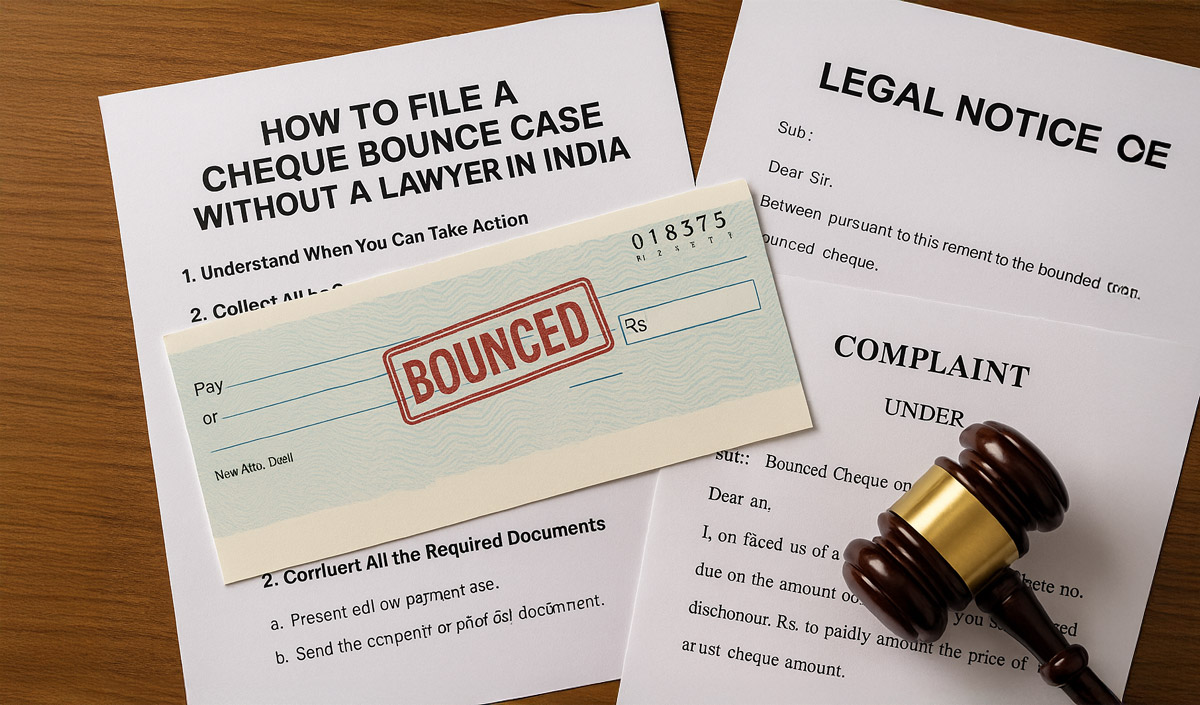When a cheque bounces, it is not only about losing money; it can also become a legal matter.
In India, cheque bounce is a criminal offence under Section 138 of the Negotiable Instruments Act, 1881.
Most people think the only way forward is to hire a lawyer. Truth is, you can handle it yourself if you’re organised and know the process. Yes, it takes a bit of time, but you’ll save on legal fees and stay in full control of your case.
Here’s exactly how to go about it.
Step 1:- Check if Your Case is Valid
You can file a case only if these conditions are met:
- The cheque was given to you for payment of a real debt or loan, not as a gift.
- The cheque was deposited within 3 months of the date written on it.
- Your bank returned the cheque unpaid, with a Cheque Return Memo showing the reason.
- The reason for the bounce is insufficient funds, account closed, or similar valid grounds.
If these conditions are not met, the court will not accept your case.
Step 2:- Collect All Necessary Documents
Keep these ready before you start:
- The original bounced cheque.
- The bank’s return memo.
- Proof of the debt (invoice, written agreement, or even bank transfer records).
- Your ID proof.
- Postal receipt and copy of the legal notice (you will prepare this in the next step).
Always keep copies of all documents for your records.
Step 3:- Send a Legal Notice
The law requires you to send a legal notice before going to court.
Here’s how:
- Write a notice stating:
- Details of the cheque (number, date, amount).
- Reason for dishonour as given by the bank.
- A demand for payment within 15 days of receiving the notice.
- Send this notice by Registered Post (AD) or Speed Post.
- Keep the postal receipt and a copy of the notice.
If the person pays you within 15 days, the matter is closed. If not, you can move to court.
Step 4:- File the Complaint in Court
If there is no payment after 15 days:
- Go to the “Magistrate Court” or “Lower Court” where your bank is located.
- Prepare a complaint petition, a short written statement about your case.
- Attach all documents:
- Original cheque
- Bank memo
- Copy of legal notice
- Postal proof
- Proof of debt
- Pay the court fee (amount depends on your state, usually a few hundred rupees).
- File the complaint within 30 days after the 15-day notice period ends.
Step 5:- Attend Hearings
Once your case is filed:
- The court will send a summons to the person who issued the cheque.
- You must attend court dates and present your documents.
- Answer the judge’s questions clearly and truthfully.
Possible Results
If the court decides in your favour:
- The person may have to pay you up to twice the cheque amount.
- They could be sentenced to up to two years in jail, but most cases are resolved before that happens.
- You may get compensation.
Typical Timeline
- Day 1: Cheque bounces → Collect documents.
- Within 30 days: Send legal notice.
- Next 15 days: Wait for payment.
- Within the next 30 days: File a complaint in court.
Key Tips
- Always deposit cheques before their expiry date.
- Keep records of all payments and agreements.
- Do not delay sending the notice; the law has strict timelines.
- Even if you handle the case yourself, you can take help from a lawyer for drafting the notice or complaint.
Filing a cheque bounce case without a lawyer in India is possible if you stay organised and follow each step on time. Keep your documents ready, act quickly, and you can handle the process confidently.

